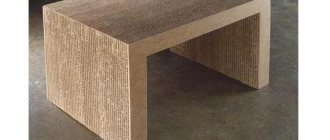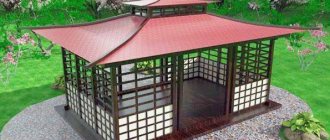The summer season will start very soon. The dacha season is a period when a huge social layer of people gets out of the cities and, loaded with shovels, rakes, hoes and string bags full of seedlings, migrates towards the dacha.
The entire future life of these people will take place somewhere between home and dacha, and so on until the harvest and the first cold weather.
Spending time in the country is a pleasant and useful activity, but not always easy. It’s good if there is a minimal benefit of civilization - electricity. And if not? Surprisingly, in the vast expanses of the CIS, even today there are many dacha areas where electricity has not yet been installed. And no matter how strange it may sound, it is not always possible to install the famous refrigerator with a handle from a ZIL car.
A similar situation is possible at the beginning of the development of a new site, when electricians have not yet connected it to the power grid. A “full-fledged” cellar would have saved the situation, but, of course, there is none, and the food supply brought from the city and local preparations must be stored somehow. And today we will talk about how you can get out of such a seemingly hopeless situation.
What to do?
In fact, the only way out is to invent a cellar. But it is not at all necessary to make the usual large cellar. Its construction may take too many resources and time, which, as we know, is always in short supply. In addition, there may simply not be enough free space for it. Therefore, we will make a mini-cellar - a one-piece structure based on a polyethylene container, which does not require large investments, labor and time.
You can “build” such a cellar yourself in just a few working days, even without serious experience in construction. You don’t have to waste time digging a large pit, pouring formwork and erecting brick walls. The idea comes down to burying a miniature version of a cellar in the ground from a plastic container of relatively modest size.
This is something between a traditional cellar and a thermos, only working in reverse, to preserve cold rather than heat. As a basis, we can offer you containers from VER T 100 with a volume of 100 liters to VER 3000 with a volume of 3000 liters. We can offer intermediate options for 200, 300, 500, 1000 and 2000 liters (see our catalogue).
The container should be dug into the ground in a free place, retreating from the nearest permanent buildings, large trees and roads by several meters, depending on the size of the container and the intended depth. Approximately a minimum of a meter for the smallest container, the height of which is 56.5 centimeters, and 3-4 meters for the VER 3000 container with a height of almost two meters. The indentation is due to the fact that the soil in the immediate vicinity of these objects cannot be weakened too much.
Cellar made of reinforced concrete rings
An option often used is a buried cellar made of reinforced concrete rings. Usually, two meter-long rings are lowered into the prepared pit, several rows of bricks are laid on top, and the bottom is filled. Sometimes one ring is enough.
This is what our user with the nickname slavontin did.
Slavontin FORUMHOUSE user
The ring is 1.5 meters, with formwork on top, the height is 2 meters.
The photo below shows a small cellar made of reinforced concrete rings with a diameter of two meters from our user with the nickname Mastr DV.
Here's how to make such a structure:
- Dig a hole 2.5 m deep;
- Lower the two rings;
- You can buy a ready-made lid, or you can pour it yourself (you need a thickness of 10-12 cm);
- Lay the ventilation pipe and wire under the light;
- Use a brick to raise the hole to the required height;
- Cover with soil.
Underwater rocks
The principle of operation of a miniature cellar is not at all different from its “big” brother; a cellar is a cellar. This means that the container should be buried below the freezing level of the soil. More precisely, deep enough so that most of the reservoir is in a zone of stable, slightly positive temperature. This is if done correctly...
But in central Russia, the freezing depth ranges from 80 to 150 centimeters, depending on the region and how severe the winter will be. Okay, let's simplify the problem: take the average value of 115 cm and roughly divide by 2. This will give us a rounded 60 centimeters - and this is the depth to which we need to additionally “sink” the container. It turns out that even if we take the smallest container with a height of only 56.5 centimeters, we will have to dig at least 120 centimeters. And for a two-meter tank VER 3000, you will have to go at least 2 meters 60 centimeters deep. This is with a container diameter of one and a half meters.
What if you do it wrong and dig the container in just enough so that the lid is just below ground level? You can, of course, do this, but no matter how you insulate the container from above, this is a hack job. You can’t leave the preparations in such a “storage” for the winter - there is a high probability that they will freeze. In the summer, of course, it will be cooler there than outside, but you obviously can’t call it a “refrigerator”, and you can hardly store perishable food there. It turns out that such a “mini-cellar” can be fully used only in the off-season, but summer residents still need it more in the summer, which means they will still have to make a mini-cellar more or less normally.
It should be noted that for a deeper container this effect will be less pronounced: in winter, products in the upper part, which are still above the freezing mark, will receive heat from deeper layers, and in summer, on the contrary, excessively heated products from above will give off heat to the lower layers . This kind of convection is observed in “full-size”, but shallow cellars, and a “large” container is somewhat closer in meaning to a “full-size” cellar.
There are two other problems associated with digging deep. The first problem is the pressure of soil masses on the walls of the container. Plastic containers are not designed for this a priori. The second is the possibility of floating in the spring as a result of active snow melting and rising groundwater. Plastic containers, as you understand, float perfectly...
Criterias of choice
When the decision to purchase has already been made, you need to know exactly what kind of cellar you need. You can purchase a finished product and have the opportunity to order according to your sizes, with or without insulation. But in any case, there are a number of recommendations that should be used when choosing:
- Availability of certificates . Since this is a place for storing food, the body is made of high-quality and environmentally friendly material. Therefore, be sure to ask the seller for documents and make sure there is a certificate for the product.
- Installation warranty . Installation must be carried out by specialists. They will assess the site, determine the groundwater level and, based on this data, select the optimal location and prepare a reliable foundation. As a rule, caisson manufacturers do the installation themselves; their employees not only know the features of their products, but also have extensive installation experience, which can significantly reduce installation time. Therefore, ask your sales representative if their company can handle the installation.
- Availability of ventilation . Typically, finished products are equipped with a standard ventilation system, but most often it has to be modified. If the entire volume of the room will be intensively used and it is planned to store a lot of products, then forced ventilation is necessary.
- Right size . The geometric dimensions of the caisson play an important role. Its price will directly depend on the dimensions, so it is important to choose the right volume and not overpay for what is unnecessary. Of course, the finished design can also be made to order, but this will require additional financial costs.
- Availability of additional equipment . Autonomous lighting, convenient stairs, temperature and humidity sensors, adjustable height and number of shelves. All this will allow you to operate the cellar more comfortably.
Installation
Both problems are solved in one pass at the stage of “installation” of the container underground. You just need to strengthen the container by filling it with M300 mortar, a cushion under the container and formwork around it. The thickness of the side wall of the solution of 3-4 centimeters will be enough to protect the container from soil pressure. During the cementing process, our improvised cellar should be filled with water to avoid deformation of the polyethylene. But if the groundwater rises too high, the container still risks floating, despite the weight. In this case, you should not take a “large” two-meter container, giving preference to a smaller one. In general, there are no universal recommendations; you need to start from each specific case.
After you have installed and cemented your future cellar, you should also do simple ventilation. For this purpose, a piece of plastic pipe of small diameter (25-32 mm) is suitable. Drill a hole at the top of the container, insert the pipe and secure it in some way. It is best to make a bracket from a metal rod, angle or profile.
When the pipe is securely in place, you need to seal the joint with the container using sealant, and at the street end of the air duct pipe you need to make protection against the penetration of rodents and precipitation. To do this, you can use a fine-mesh metal mesh and a cap. From the pit, which is formed as a result of the difference in height between the level of the container lid and the ground level, it is necessary to make a drainage channel so that water does not accumulate in it (if there is nowhere for the water to drain, then you will have to dig a second hole nearby a little deeper than the pit). Finally, all that remains is to assemble the canopy from the boards and insulate it.
In principle, such a mini-cellar can perform its function for decades. The disadvantage of the cellar is that such a design, let’s say, is not entirely convenient to use. The lid of the container is located at least 60 centimeters below ground level, that is, if you want to get something out or load it into it, you will first have to remove the canopy and go down into the pit, and only then, by unscrewing the lid of the container, begin the process of “lifting” the supplies provisions from the depths of the container or “immersion” into them through a neck 30-40 cm in diameter.
And if in the case of containers up to a meter high, it is still possible to somehow reach the bottom (but you are unlikely to like this process from an upside down position in the pit), then if you take a container two meters high, the only possible way of loading will be the alternate lowering of groups of products in (strong) bags and sacks on ropes, as well as the ascent. Most likely, this is the only adequate way.
When do you need an underground cellar?
In-depth cellars are located entirely underground, so the composition of the soil (only clayey ones are suitable here) and the groundwater level (permissible depth - at least 2-2.5 meters) are of great importance for their construction. In a damp area with a close groundwater level and high water with a buried pit, you won’t have any troubles and will be exhausted in pumping out water - it will be right to choose above-ground structures.
ChapelenForumHouse Member
I have a cellar in the Moscow region under the kitchen floor 80 cm deep. It floods halfway during long rains and melting snow in winters with little snow. No amount of sealing helps.
The simplest option for a buried cellar is a structure with earthen walls and an adobe floor. The height from the base to the ceiling should be 1.8 m. It is allowed to add soil to raise the bottom.
The walls of the pit should not be strictly vertical, but inclined at a slight angle, then they will not crumble.
To protect against capillary moisture, it is recommended to pour a five-centimeter layer of crushed stone impregnated with hot bitumen on the bottom, and then make an adobe floor on top (about 10 cm) with the addition of small crushed stone.
Andrey506FORUMHOUSE user
Moist air always comes from the ground; moisture condenses on the cold parts of the underground. With all the ensuing consequences (dampness, mold, mildew, etc.).
How such a structure is made can be seen in the diagram.
The cellar is covered with a ceiling, insulated and covered with earth. Previously, a cellar was always placed on the pit - a building in the form of an insulated gable roof. There you can organize temporary summer storage of supplies and keep gardening tools, materials, etc. there.
In hard soils, earthen walls are sufficient for long-term use without any problems. This is a great option for a summer residence. If the soil is weak, then the walls need to be strengthened - in the Russian burial tradition, logs were used for this, now the walls are increasingly reinforced with concrete or red brick. An excellent cheap option for strengthening the walls of a cellar in a country house is sheets of used slate.
How to find the groundwater level in your area
Water is the main enemy of all building structures, especially those located underground. To find out the groundwater level on the site, it is recommended to conduct small geological studies:
- Drill a hole 3 m deep. It is better to work in late autumn or spring. If the groundwater level is close, a wooden pole lowered into the well will be wet.
- Contact your local hydrogeological organization. There are all the answers regarding questions about UGV.
- Talk to your neighbors. Usually, nearby areas have similar conditions.
- Explore the area for the growth of moisture-loving plants - horse sorrel, sedge, nettle, alder, willow and others. If they are abundant on the site, groundwater is very close.
Nearby ditches, wells, and boreholes are also a source of information. Another telltale sign of a nearby aquifer is heavy dew falling at night. If, in addition to a high groundwater level, the soil has a clayey composition, building an underground cellar is very risky. It is better to focus on more “elevated” options.
Walls and roof
Many owners of earthen cellars advise making walls from bricks. But much more material will be used on the walls than on the floor. This means that such walls are very expensive. Therefore, wooden walls would be an ideal option here. You can use inexpensive timber.
But the design of the roof depends solely on your preferences. The main thing here is to adhere to a single, but very important rule - the roof must be absolutely waterproof.
Allowing the slightest dampness in an earthen cellar is simply unacceptable.
Necessary materials
If you decide to make such a cellar for yourself, prepare the following materials.
- A metal barrel of the required size.
- Paint or bitumen mastic, which will serve as a waterproofing coating and extend the life of the cellar.
- To paint the inside of the container, you will need water-based paint.
- Boards for making a cellar lid. As a result, the lid should be sealed; it must be insulated.
- Metal pipes or wooden bars.
Where can I buy
Popular models can be purchased from manufacturers or dealers, where the best new products are presented. There you can study the characteristics in detail, compare parameters, look and touch them with your hands. Consultants will explain in detail and give valuable advice - what they are, how to choose, how much it costs.
In addition, the required product can be ordered online in the online store or on the pages of the Yandex.Market aggregator. Before ordering, be sure to read the description, look at photos and diagrams of installation and installation instructions, as well as user reviews.
Useful tips
At first glance, building a cellar with your own hands is a simple matter. But every builder needs to remember:
- choose a location at a higher elevation, away from sources of pollution;
- The groundwater level must be at least 0.5 m below the floor;
- use materials that are resistant to moisture and decay, carry out protective treatment;
- foundation drainage, although not necessary, is very desirable, especially for regions with high precipitation rates or areas near water bodies;
- do not forget to reinforce the masonry;
- Observe electrical safety precautions when laying wiring.
Good insulation, reliable waterproofing and effective ventilation will help you preserve the harvest in the cellar without loss.
Insulation
During severe frosts, the cold penetrates into the room through the weakest points - hatches, doors, insufficiently insulated walls and ceilings. If frost is periodically detected somewhere inside the cellar, then the thermal insulation is not coping with its function.
In underground basements, the entrance area and ceiling most often freeze. For insulation, you can use polystyrene foam, polystyrene foam, polyurethane foam, securing them to the surface using dowel bends or glue and filling the joints with polyurethane foam.
Polymer materials have very low thermal conductivity and are not afraid of moisture. Their only enemy is rodents. To protect the insulation from mice and rats, it is recommended to cover the materials with a fine-mesh metal mesh.
Wooden floor
Wood is not the best material when building an earthen cellar. No matter how you process it, over time it will undergo a process of rotting and then problems cannot be avoided. You can use it in the form of boards, but only in a dry basement.
If you still opt for a wooden floor, then first of all provide a mound of sand and gravel mixture, then lay waterproofing material, and then put boards on it.
Do not forget to treat all wooden elements with a special product.
Ventilation system
Without good ventilation, it is unlikely that it will be possible to preserve supplies for at least some time. Properly organized air exchange will not only reduce air humidity, but also get rid of harmful radon, methane and carbon dioxide, which are dangerous at high concentrations.
A simple but effective ventilation system for a small cellar consists of 2 pipes located in opposite parts of the room at different heights:
- The supply channel is led outside and supplies clean air. The bottom of the pipe should be at a height of 30-70 cm from the floor.
- Exhaust air is removed through an exhaust pipe fixed to the ceiling and vented to the atmosphere. To create good traction, the top of the pipe must be located at least 0.5 m above the roof level.
Pipe sections on the street are insulated. External openings are covered with protective caps, internal ones - with rodent nets. If there is insufficient ventilation, a duct fan is built into the system.











